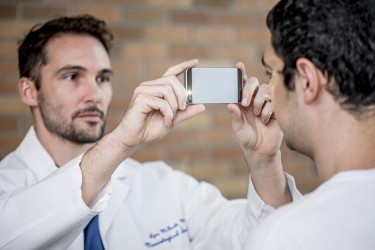
Congratulations to Dr. McGrath whose presentation “Mobile Digital Pupillometry for Rapid Triage of Patients with Severe Traumatic Brain Injury” earned him the prestigious Innovator of the Year award at this year’s Congress of Neurological Surgeons meeting.
Traumatic brain injury (TBI) is the leading cause of mortality in people under age 45 and accounts for 2.5 million ED visits and $75 billion in healthcare costs each year in the United States.(1-3) The key to ensuring the best possible clinical outcome for TBI patients is to facilitate their care at a designated trauma center. Unfortunately, up to 60% of severe TBI patients are undertriaged and admitted to non-trauma hospitals, a systemic problem which the National Study on the Costs and Outcomes of Trauma has demonstrated results in an excess mortality of 25%.(4, 5) Evaluation of the pupillary light reflex (PLR) is a crucial factor in triaging TBI patients, but penlight-based manual pupillometry is known to be inaccurate and digital infrared pupillometry impractical for field use. PupilScreen, a pupillometry technology developed for smartphones, integrates the convenience of manual pupillometry with the accuracy of a digital infrared pupillometer and may represent a practical way to improve the triage of severe TBI patients.
A smartphone-based pupillometer, PupilScreen, was developed utilizing a fully convolutional neural network (FCNN) and the flash and camera from a typical iPhone. The FCNN was trained for 175,000 iterations on a database consisting of 4410 pupil image samples from 42 healthy volunteers and 7 TBI patients. Once sufficient accuracy in generating PLR curves was achieved (0.3mm mean error in diameter estimation), the trained network analyzed n=48 new samples (n=24 from healthy patients and n=24 from patients with severe TBI [GCS <8]). PLR curves were generated for each cohort and presented to two blinded clinicians to assess each pupil as either 'responsive' or 'non-responsive'.
When presented with PLR curves, one blinded clinician was able to correctly classify a patient as demonstrating 'responsive' or 'non-responsive' pupils with 100% accuracy, and the other with 99% accuracy (one 'non-responsive' curve was misclassified as 'responsive'). While limited in scope, these results demonstrate substantial improvement over manual pupillometry.(6-8)
A smartphone-based pupillometer can provide PLR assessments accurate and intuitive enough for clinicians to identify one of the clinical hallmarks of TBI, and may be useful for patient triage.



















